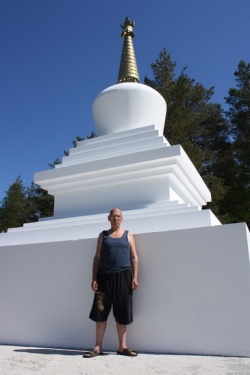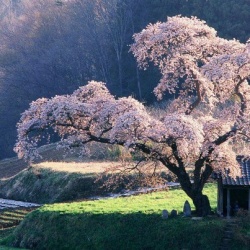Silence in monastery
When I began training as a nun, silence was foreign territory, difficult to explore. I was born on an army base with the band playing reveille in the morning and taps in the evening over loudspeakers. At home in cities and the modern world, I took my first solo journey by air when I was six. As a teen in the 60's loud music accompanied me everywhere. Even when I moved to the country, I filled the quiet easily with music and tapes. Work and ubiquitous background noise filled my life, and I took little time for solitary walks.
The first time I encountered silence in meditation, I could barely sit still for a minute. The thoughts and feelings that flooded my mind felt like a hurricane and I wanted to jump up and run. Classic descriptions of mind in Buddhist philosophy are that of a monkey or a wild stallion. Monkeys swings from branch to branch while stallions buck and race, resisting any training. Our culture promotes speediness and entertainment.
Our minds, continuously stimulated, move faster and faster. We are distracted constantly by music, TV, and computers that we now carry everywhere we go. Information speeds up almost every day. It is generally so uncomfortable for us to be in silence that deprivation is considered torture or punishment.
All monasteries have silence in common. Quiet contemplation is considered essential to find peace of mind. When you open the door to a monastery, silence is as palpable as the coolness when opening a refrigerator. The silence both welcomes and engulfs you. But quiet as a way of life is not easy. Within minutes you know something about the mental states of the community members.
The residents create a field of minds, a group sensation. There are varieties of this aspect of silence; precise, spacious, content, painful. One monastery seemed like its location on the edge of a cliff overlooking an ocean, vast and focused; while another abandoned silence at meals temporarily because the community needed to heal hearts with direct communication. Despite conversation, that monastery felt empty and lonely.
Entering my monastery, I committed to silence for most of every day; from 7 in the evening to noon the next day. At first during these non-speaking periods, I asked myself "Can I fit into a routine of silence without resistance?" and "How much do I need to talk to feel real to myself?" Silence was surprisingly anonymous.
I discovered that I had defined myself by speaking about my life - sculptor, teacher, daughter, student. At the same time my inner dialogue continually reinforce my ego. Do I like this or that? Agree with this or that? I am better than, less than. Pride arose; a belief that my inner commentary was significant, worthy of hearing, tempting me to whisper to a colleague.
We were able to begin speaking again at lunch. The last 5 minutes seemed the hardest, then an uproar was unleashed. "I am" chorused in thirty different voices in thirty different ways. Daily my understanding of silence deepened. Outer circumstances of quiet solitude are not enough. One has to quiet the mind to love silence. The inner dialogue also has to diminish. I am easily caught up in thoughts of past or future. Occasionally I feel content, at home with my mind. Even more rare are glimpses of peace like an ocean of space within. I practiced many kinds of meditation to achieve peace.
In the beginning, meditators learn techniques to focus mind on one thing at a time and to maintain that focus. In walking meditation, you concentrate on your body movements. In breath meditation you stay focused on the simple sensation of breathing. These practices begin in the meditation hall for short time periods. As you become experienced, inner concentration can be maintained as you walk to get tea, or to the bathroom. This is a lifelong process that varies in application with mood and circumstance. Many days I am lost in thoughts before I fully stand up from my cushion.
The practice is to notice when you become distracted and then return to the object of concentration. You notice when you are distracted when you try to concentrate. Eventually you are able to control where you place your mind and keep it there. When you are able to hold a focus, you have choices about the object of concentration. Choice is the key to peace.
A thought of irritation can be felt, experienced and discarded, replaced with a thought of appreciation. Slowly, with patient repetition the mind slows from a torrent of thoughts cascading over a cliff to a deep still pool. One thought rises at a time and subsides. Patterns that have tormented us for years become visible. When we finally see how our minds work we learn to interrupt patterns of discord as they arise and to choose to activate kindness. The silence of the monastery is rich with investigation and attention to choices.
Sundays we were in silence all day. Even meals became meditation as we practiced a formal ritual called "Orioki". A Japanese word that means "enough"; orioke is zen custom of ritualized meals. Every movement was choreographed in unison; from unwrapping a napkin covered set of dishes, to wiping them clean at the end. Serving and receiving food was like a ballet with graceful hand gestures to indicate what was needed.
Many silent days I felt refreshed, my stresses and anxieties temporarily pacified. This fleeting contentment was not a smooth process. Anger can rage over simple things: a misinterpreted glance, a tone of voice that evoked a history of hurt. Resistance arose. Is discipline in very detail of life really necessary? Loneliness visited often, I missed friends and family.
I did not choose my companions in the monastery or always like them. Eventually I was able to see where these thoughts of like and dislike originated. They were my own mind creating judgments. I discovered how rarely I was in the present moment with attention to breath or movement. The sameness of silent routine allowed me to experience my thoughts in slow motion and understand that I created habits and patterns.
The year in the monastery was divided into times of study, programs for guests and personal retreats. The studies interrupted the morning silence as we debated the nature of reality in our classes. My mind grew excited as I was stretched intellectually. We invited groups in to share our practice and this required organization and much preparation, our "work". These periods of activity were balanced with solo retreats. I began with weekend retreats and progressed to months.
Retreats are meditation Olympics where rigorous mental training is accomplished. One is given rituals of increasing difficulty that are repeated continuously hundreds of thousands of times. One maintains a strict schedule beginning at 4 am and ending at 9PM. Silence is uninterrupted. You are even more alone with your mind, seeing no one.
When you are sitting on your cushion with no other activity available, every mental distraction is obvious. In addition, the system of rituals seems systematically designed to invite unwelcome aspects of mind to come forward. It is tremendously difficult physically to hold a meditation posture and concentrate for hours. Also there are in between times of cooking and cleaning, times when rest is needed and the mind runs. Silence also holds the potential for madness.
Early in retreat training an involuntary life reviews occurred of every hurt I had inflicted on others, all the ways I withheld love. Sometimes in the middle of meditation a strong memory erupted. Contemplation halted and I was lost in the past. Wounds were licked until no skin was left. At other times the repetition of mantras seemed unbearably boring and my mind desperately searched for entertainment.
Every jingle of every commercial I ever saw on TV as a child was replayed. It is an interesting process to become so weary of your own thoughts, inner demons and battles that you can no longer stand to call them to mind. I was endlessly capable of relentlessly creating new wounds to review, new passions to inflame my mind.
Nauseated by the constant uproar, one day I suddenly let go. I chose not to go into the pain of the past one more time. I saw that my long list of hurts was just one feeling, anger was anger and it was mine to drop. I was not that feeling, it did not define me. I could make a choice. I was free to think differently. I could just let the thoughts simply fall away, like shaking water off an umbrella.
How wonderful. It is quiet, the sun is shining or not. Food is tasty or not. A deep peace, a vastness replaced the endless chatter. I woke to the sounds of whales breathing below my windows. The quiet was within and without.
The first time this happens it is exciting. You so much want it to last. Then all the old stuff returns in the next meditation. And added are new judgments. "I did not do well today. I didn't reach the good part of meditation." The subtle difference with time is that you recognize the patterns and wounds for what they are; tendencies to have certain buttons pushed, new characters but a familiar movie.
They say that children will scratch a rash until they bleed. Animals lick themselves raw. I think mentally we are like that. One moment of relief does not change a lifetime of licking.
It has taken me 25 years to be at home with silence. I know now there is an ocean within, and that I can tap into it. That I remember more and more often to do so is enough. Peace of mind is reachable when I am able to look without judgment at all that arises in my mind. Each newly arising anger, fear, stress must be faced and abandoned. Sometimes I can remember to let go as it arises.
Other times it takes work. Afterwards an alert joy arises in just being. One snowy night I walked with a clear mind. I heard a snowflake drift and settle onto my coat. I may not have that clarity all the time, but I know I carry the potential.





